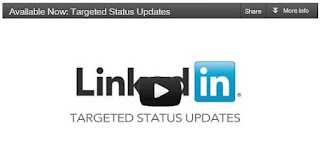 With a gazillion cool features, LinkedIn is by far one of
the finest tools for business networking.
And, just when you thought it couldn’t get any cooler – yet another
brilliant feature: Targeted Status
Updates. This feature essentially enhances
the relevance of conversations between LinkedIn users and companies. Originally launched in April, but only made
available to a few companies, Targeted Status Updates is now open to all
businesses that have LinkedIn Company Pages.
And, that’s over two million!
With a gazillion cool features, LinkedIn is by far one of
the finest tools for business networking.
And, just when you thought it couldn’t get any cooler – yet another
brilliant feature: Targeted Status
Updates. This feature essentially enhances
the relevance of conversations between LinkedIn users and companies. Originally launched in April, but only made
available to a few companies, Targeted Status Updates is now open to all
businesses that have LinkedIn Company Pages.
And, that’s over two million!
Targeted Status Updates facilitates the flow of pertinent information
between users and the companies they follow.
In the words of LinkedIn project manager, Mike Grishaver, “...companies
can now communicate with their followers in a very personalized way and provide
content tailored to specific audiences.”
Now, when you follow a company on LinkedIn, information,
news and updates (industry trends, job opportunities, product & service
information, etc.) are sent to the activity stream. And, the amount of relevant content that you
receive is proportional to how much and how often you engage with a company.
Businesses can target their status updates to users based on
company size, industry, function, seniority and geography. It streamlines the information that you
receive and makes it much easier to follow companies.
Here’s how it works:
Log into your company’s LinkedIn page. Type the content you want to share into the “Share
an update” box. Click on the dropdown
menu beside “Share with: All followers”, then click on “Targeted audience”.
The next window you see will read, “Specify a target
audience” at the top left. Select the
criteria for your target audience from the options listed across the top of the
box: “Company size”; “Industry”; “Function”;
“Seniority” and “Geography”.
It’s as simple as that!
Now, not only will your status update be visible on your company page,
but it will appear on the homepages of followers whom you have targeted via the
criteria you selected.
And, it doesn’t end there.
Analytics for each post are available following a twenty-four hour
period. The company page admin will be
able to see these analytics, which include how many impressions the update
received; how many clicks it garnered; how many times it was shared and the
engagement percentage, underneath each post. Targeted Status Updates is a
brilliant means of streamlining what and to whom you post on LinkedIn.
According to an article on
brandchannel.com, “LinkedIn found that 67%
of members follow a company to gain industry insights, 61% for company news,
and 49% for the peer community.”
Targeted Status Updates is a
brilliant means of streamlining what and to whom you post on LinkedIn. Just another way that LinkedIn makes social
media marketing a breeze!



